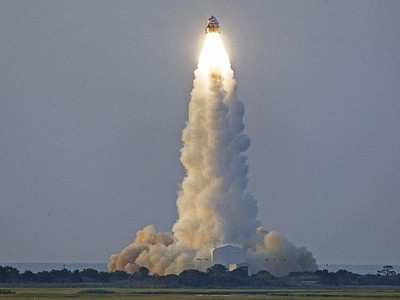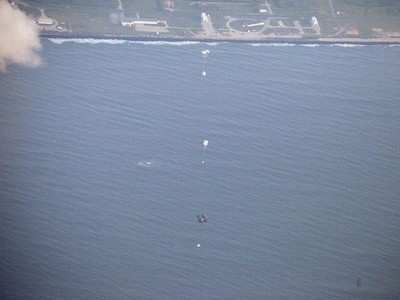Launch Emergency Simulation Was Successful
NASA has successfully demonstrated an alternate system for
future astronauts to escape their launch vehicle. A simulated
launch of the Max Launch Abort System, or MLAS, took place
Wednesday at 0626 at NASA's Wallops Flight Facility, Wallops
Island, VA.

The unpiloted launch tested an alternate concept for safely
propelling a future spacecraft and its crew away from a problem on
the launch pad or during ascent. The MLAS consists of four solid
rocket abort motors inside a bullet-shaped composite fairing
attached to a full-scale mockup of the crew module.
The 33-foot-high MLAS vehicle was launched to an altitude of
approximately one mile to simulate an emergency on the launch pad.
The flight demonstration began after the four solid rocket motors
burned out. The crew module mockup separated from the launch
vehicle at approximately seven seconds into the flight and
parachuted into the Atlantic Ocean.

The test demonstrated a number of things: the unpowered flight
of the MLAS along a stable trajectory; reorientation and
stabilization of the MLAS; separation of the crew module simulator
from the abort motors; and stabilization and parachute recovery of
the crew module simulator. An important objective of the test was
to provide the workforce of NASA's Engineering and Safety Center,
or NESC, with experience in flight testing a spacecraft concept.
NESC leads the project at NASA's Langley Research Center in
Hampton, Va.
NASA has chosen another launch abort system, known as the LAS,
for the Orion spacecraft. The system has a single solid launch
abort motor in a tower mounted at the top of the launch vehicle
stack of the Orion and Ares I rocket. The LAS will be capable of
automatically separating the spacecraft from the rocket at a
moment's notice to make possible a safe landing. Orion, part of a
new spacecraft system NASA's Constellation Program is developing,
is undergoing design reviews in preparation for flying astronauts
to the International Space Station in 2015 and, later, to the
moon.

Data from today's MLAS pad abort test could help NASA in several
ways. MLAS is the first demonstration of a passively-stabilized
launch abort system on a vehicle in this size and weight class. It
is the first attempt to acquire full-scale aero-acoustic data --
the measurement of high loads on a vehicle moving through the
atmosphere at high velocity -- from a faired capsule in flight. The
test is also the first to demonstrate full scale fairing and crew
module separation and collect associated aerodynamic and
orientation data. In addition, data from the parachute element will
help validate simulation tools and techniques for Orion's parachute
system development.

The NESC is an independently funded NASA program that draws on
technical experts from across all NASA centers to provide objective
engineering and safety assessments of critical, high risk
projects.
The MLAS is named after Maxime (Max) Faget, a Mercury-era
pioneer. Faget was the designer of the Project Mercury capsule and
holder of the patent for the "Aerial Capsule Emergency Separation
Device," which is commonly known as the escape tower.
 SpaceX to Launch Inversion RAY Reentry Vehicle in Fall
SpaceX to Launch Inversion RAY Reentry Vehicle in Fall Aero-News: Quote of the Day (04.23.24)
Aero-News: Quote of the Day (04.23.24) Aero-News: Quote of the Day (04.20.24)
Aero-News: Quote of the Day (04.20.24) ANN's Daily Aero-Linx (04.20.24)
ANN's Daily Aero-Linx (04.20.24) Aero-News: Quote of the Day (04.21.24)
Aero-News: Quote of the Day (04.21.24)






